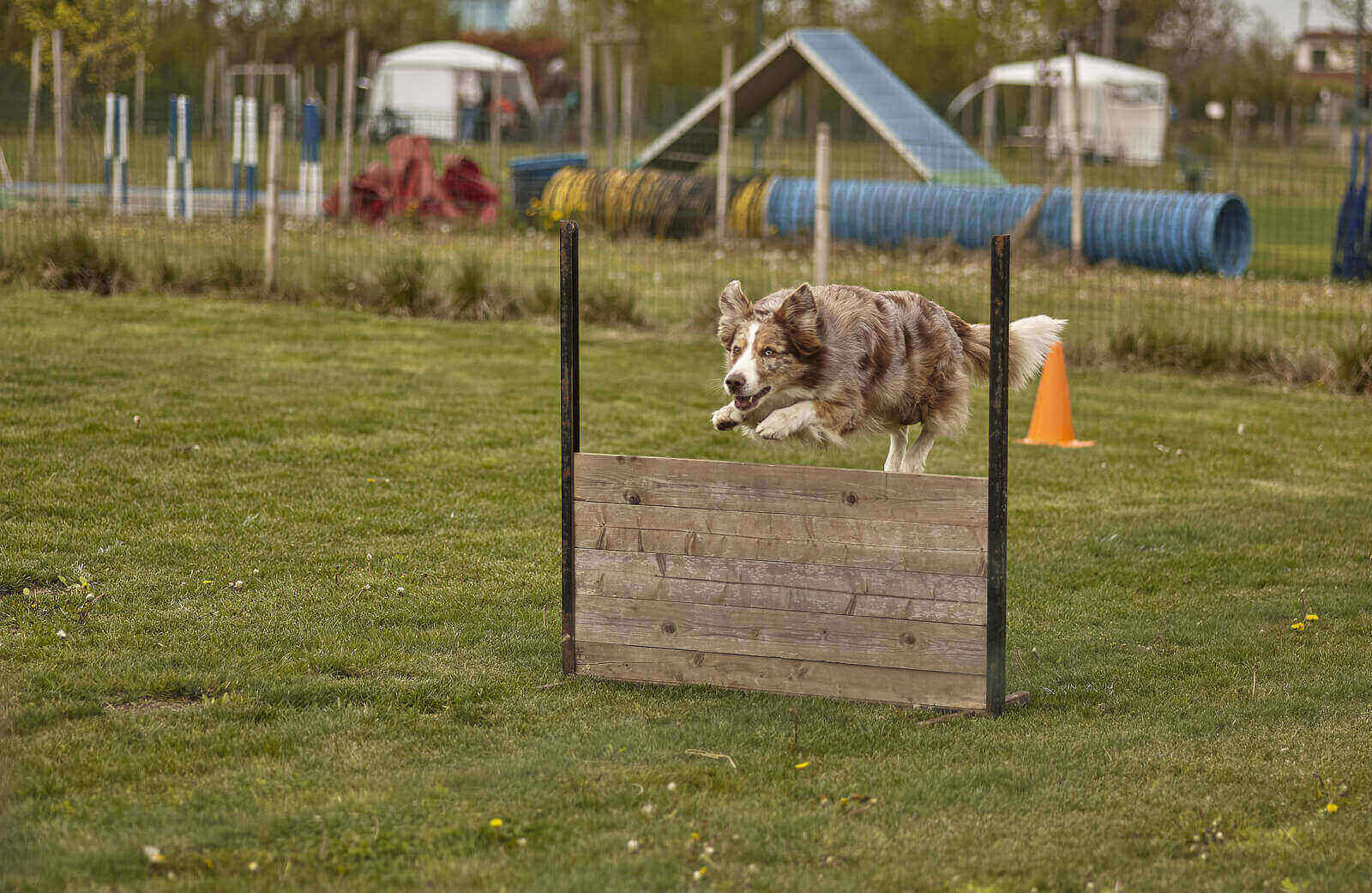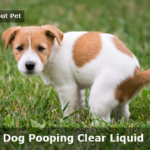Discovering that your dog has been vomiting is bound to cause you some concern. You will definitely want to know why the dog has been vomiting, and what you can do about it. And one way to do that is by looking at the dog vomit color. In this article, you will find comprehensive information on what the various dog vomit colors mean.
The key colors in the dog vomit color chart include yellow, brown, green, black, white and red. Yellow, green and orange may be indicative of bile in the dog vomit. Brown, pink, red and black (coffee ground hue) may be indicative of blood in the dog vomit. White/clear liquid color may be due to the dog vomiting on an empty belly.
Whether or not a dog’s vomiting should be too a great cause of concern depends on several factors. It of course depends on the color of the dog vomit. But it also depends on the texture of the vomit, as well as the frequency with which the dog is vomiting.

Why Do Dogs Vomit?
Before delving into the dog vomit color chart, it is important for us to first pause and establish why dogs vomit.
Sometimes, dogs vomit when they eat something that upsets their stomach. This may be something that is new in their diet. Or it may be due to eating something that is spoiled.
At other times, dogs’ vomiting is a sign of infections.
There are also times when we have dogs vomiting because they have eaten too much or too fast.
In some cases, dogs’ vomiting may be due to ingestion of toxins. There are also cases where dog’s vomiting is due to ingestion of foreign objects, which sometimes cause intestinal blockages.
We also have cases where dogs vomit due to motion sickness. That is how, for instance, you have a case of a dog vomiting but acting normal.
It is of course important to differentiate incidents of dogs vomiting from incidents of dogs regurgitating food/water.
In the strictest sense, vomiting entails bringing back food that is partially digested. This is food that has made its way to the dog’s stomach. Vomiting normally entails retching, with abdominal contractions. The dog may drool before and after vomiting…
Regurgitation, on the other hand, entails bringing food that is completely undigested. So this is food that has not made its way to the dog’s stomach. It is brought back from the esophagus or pharynx level. There may be no abdominal contractions accompanying regurgitation.
So where you have a dog vomiting undigested food from its esophagus/pharynx, it may be a case of regurgitation, rather than real vomiting.
What Color Is Dog Vomit?
Another question we need to explore, before delving into the dog vomit color chart, is that on what the typical dog vomit colors are.
As it turns out, dog vomit comes in many colors. Sometimes, dog vomit is brown in color. At other times, it may be orange or red. There are also times when dog vomit is green, black, gray, pink, white or clear in color.
Therefore the range for normal dog vomit color is broad.
Of course, there are certain dog vomit colors that are rare. Blue is one example of a rather abnormal dog vomit color. If you have a case where your dog is throwing up blue vomit, and you pose the question on why is my dog’s vomit blue, you may draw blank stares…
Indeed, if you go through most dog vomit color chart guides, you notice that colors like blue are not covered. That is because they are rather uncommon. Even blue dog vomit pictures are hard to find anywhere.
All in all, common dog vomit colors are the likes of brown, orange, red, green, black, grey, pink, white and clear. What makes dog vomit color guide analysis difficult is the fact that the vomit may be in different hues of the respective main colors.
For instance, you may have dog vomit that is basically red in color, but which due to mixture with other substances, has a pink hue. Yet you may not find pink in most dog vomit color chart guides…
So there is no one specific color we can pick and refer to it as the ‘normal’ dog vomit color. Instead, we can assert that dog vomit comes in an array of colors – ranging from brown to orange, red, green, black and pink as well as white and ‘clear’.
What Does The Color Of Dog Vomit Mean?
From the dog vomit color, it is possible to get hints on why exactly the dog is vomiting. This is why the dog vomit color chart is so important.
For instance, if a dog vomits green, and it had not eaten green stuff, the inference is that the green color is due to bile presence. So, in this case, you know that the dog is vomiting bile. This may in turn be due to reflux. Or it may be an indication that the dog is vomiting on an empty stomach.
If a dog vomits red, it may be an indication that there is blood in the dog’s vomit. This may be due to tearing up of the dog’s stomach lining. Or it may be due to the presence of ulcers. Or it may be due to some other gastrointestinal irritations.
But it may also be simply due to the dog having eaten food with red dye!
Yellow may also be indicative of the presence of bile.
Brown may mean that the dog has eaten food with brown dye. Or that the dog has been eating poop. But it could also mean that there is blood in the vomit.
Black can be a sign that the dog had eaten black stuff – possibly mud, other animals’ droppings or dirt. It could also be indicative of blood that has been in the tummy for a while. Or it could be indicative of a toxin that the dog’s body is getting rid of.
White or clear vomit may mean that the dog is vomiting on an empty belly…
Thus, the dog vomit color chart is very critical. This is because, as we can see above, it is possible to pinpoint exactly why the dog is vomiting by checking the vomit color.
Why Is My Dog Vomiting Yellow?
If you have a dog vomiting yellow, then it is indicative of the presence of bile. In most cases, for a dog to vomit bile, it means that there is nothing in its stomach.
Therefore if you have a case of a dog vomiting yellow liquid, there are two inferences you can make. Firstly, you can infer that there is bile in the dog’s vomit. And secondly, you can infer that the dog’s stomach is empty.
This thus implies that the vomiting is not due to something that the dog has eaten recently.
These are also the inferences to make, in the case of a dog vomiting yellow foam or a dog vomiting yellow smelly liquid. Even when you have a dog vomiting yellow mucus, it is still likely to be indicative of the presence of bile.
Naturally, the question that follows is on why is my dog vomiting yellow foam? Or, more specifically, why is my dog vomiting yellow bile?
And the deeper underlying reason behind bilious vomiting syndrome may be something to do with bile finding its way from the small intestine into the stomach.
That can be due to the dog eating too much fatty food. Or it may be due to the dog not eating for a long while. It can also happen due to the drinking too much water.
There are also instances where the yellow vomiting is due to the dog eating grass. Thus, an incident of dog eating grass vomiting yellow bile may be quite ordinary – though not necessarily normal.
Indeed, dog eating grass and vomiting yellow stuff is quite a common occurrence.
The yellow vomit can also be due to parvovirus infection. In answering the question on what does parvo vomit look like, yellow is one of the colors that are given.
Brown Dog Vomit – What Does It Mean?
There are three key possible reasons for a dog throwing up brown vomit.
The first and most benign possibility is that of the brown vomit being due to the dog having eaten food with brown color.
Many dog kibbles have brown dye. If a dog eats such kibble, and proceeds to throw up, the vomit will tend to be brown in color. This may therefore be the reason behind the light brown vomit dog throws up.
The second key possibility is that of the brown vomit being due to the dog having eaten its own poop. So if you have a case where dog vomit looks like poop (and is brown in color/smelly), this is what you may be looking at.
The third possibility is that of the brown color being due to the presence of blood in the vomit. A small amount of blood in dog vomit will usually cause a brown hue. Indeed, most pictures of dog vomit with blood have a brown hue.
Brown should arguably be one the first colors in the dog vomit color chart. That is because it is one of the commonest colors in which dog vomit comes in.
In some cases, brown dog vomit may not be cause for too much concern. This is the case if, for instance, it appears to be due to the dog having eaten brown colored kibble.
But where, for instance, it seems to be due to the presence of blood in the vomit, it should cause some alarm.
The symptoms accompanying it are also worth paying attention to. For instance, if you have a dog vomiting brown liquid and not eating, then it should be reason to consider consulting your vet.
Why Is My Dog Vomiting Green?
Green is yet another common color in most dog vomit color chart guides. So, what does it mean when your dog vomits green? There are two key possible inferences.
The first and most benign possibility is that of the green color being on account of the dog having eaten green stuff. It is not uncommon, for instance, for dogs to eat grass. When they do, they sometimes end up throwing up vomit that is green.
The second and more worrying possibility is that of the green color being on account of presence of bile in the vomit. We earlier said that the commonest reason for dogs vomiting yellow is the presence of bile. That is also what applies for green vomit.
Sometimes, instead of dogs vomiting yellow bile, they throw up green bile. Thus, in some cases, the cause for a dog vomiting yellow is the presence of bile in the vomit. In other cases, the presence of bile makes the vomit green, rather than yellow.
Admittedly, there can be confusion here: where the yellow dog vomit color guide says that it is due to the presence of bile, yet another guide says that green is also indicative of bile…
The true position is that green is indicative of much bile in the vomit. Yellow, on the other hand, is indicative of less bile in the vomit.
It may be rare to hear of a case of where a dog threw up yellow liquid and died. But a case of a dog throwing up green liquid (concentrated bile) and dying thereafter would be more of a likely occurrence.
Ultimately, we see that the green dog vomit may be due to the dog having eaten green stuff. Or the green color may be indicative of the presence of bile.
Why Does My Dog Vomit Black?
A dog vomit color chart will be incomplete if it doesn’t include black. Of all types of dog vomit, that which has black color may be the most disconcerting. This is what makes the inclusion of black in the dog vomit color chart so critical.
If your dog is vomiting black, there are three key possibilities.
The first possibility is that of the black color being due to the dog having eaten dirt or mud. It may also be a case where the dog has eaten another animal’s droppings, and they are black in color.
The second possibility is that of the black color being due to the dog having ingested some sort of toxin that is now being expelled.
The third possibility is that of the black color being due to the presence of digested blood in the dog’s vomit. So this would be blood that was in the dog’s digestive tract for long. (So it may be on account of the dog having ulcers).
Most of us imagine that in any case of dog vomiting blood will manifest through red vomit. But there are cases where the blood stays inside for so long that it darkens. So it comes out with a blackish hue, similar to coffee grounds.
Where the black vomit is due to eating mud/dirt, it may resolve by itself. But where it is due to ingestion of toxins or internal bleeding, it is more worrisome. In that case, you may be in as bad a situation as someone trying to figure out dog vomiting yellow bile not eating what to do.
Ultimately, where the black dog vomit seems to be due to toxin ingestion or internal bleeding, urgent veterinary attention is necessary.

What Does White Dog Vomit Mean?
In some cases, where a dog throws up white vomit, it means that it is having a stomach upset.
Where the white vomit is in the form of a foam, it may mean that the dog is experiencing bloating or possibly even an intestinal blockage. So you find that the dog is trying to vomit, without success: hence the white foam.
Some dog vomit color chart guides omit white. Yet if you come to think of it, when it comes to dog vomit color white can be very significant. For instance, a dog vomiting white foam may be having an intestinal blockage, which requires urgent veterinary attention.
Thus, a case of a dog vomiting white foam is not to be taken lightly – especially if it seems to persist.
Another inference, if you have a dog vomiting white foam slime is that it is vomiting on an empty stomach. So the vomiting is not due to something the dog has eaten recently. This should be even more reason for worry.
That case may not be as dramatic as in the case of a dog vomiting bile.
In terms of the optics, the case of a dog vomiting yellow liquid or a dog vomiting yellow foam may appear direr than that of a dog vomiting white foam. But in terms of deeper implications, the case of a dog vomiting white may actually be worse.
The Dog Vomit Color Chart
Dog Vomit Color Chart | |
| Dog Vomit Color | Possible Meanings for Dog Vomit Color |
| Brown |
|
| Red/Pink |
|
| Orange |
|
| Yellow |
|
| Black |
|
| Grey |
|
| Clear liquid |
|
| White foam |
|
| Green |
|
Dogs Pink Vomit – What Does It Mean?
Sometimes, dog’s vomit takes on a pink hue. So you may have a dog vomiting pink foam. Or you may have something giving the normal (liquid/chunky) dog vomit pink tinge. This warrants the inclusion of pink color in the dog vomit color chart.
So, what does pink dog vomit mean? What causes pink vomit in dogs?
There are cases where the pink color in dog vomit may be on account of the dog having eaten food that had pink/red hue. So when it throws up, the vomit is pink.
There are also cases where the pink color in dog vomit may be indicative of bleeding in the dog’s stomach. In other cases, the bleeding that gives rise to the pink vomit is further down the GI tract.
Thus if my dog threw up pink vomit or if my dog has pink vomit, these are the possibilities I would think of.
Making sense of dog pink vomit causes is reasonably easy. Had the dog eaten food with a red/pink dye? Then that is the most likely cause.
But if the dog hadn’t eaten anything with red/pink hue, yet it is throwing up pink vomit, the most likely reason is bleeding somewhere in the GI tract.
The discovery of pink blood in dog vomit should always trigger some concern. This may be what is at play if you have a dog vomiting pink liquid or dog vomiting pink foam.
Even the presence of light pink blood in dog vomit should be cause for alarm. One would go as far as even saying that any pink bile vomit dog throws up is cause for concern.
Remember, what may make a dog vomit pink foam may be the case where it has bleeding in the GI tract: which is worrisome.
Why Is My Dog’s Vomit Grey?
There are relatively rare occurrences in which dog’s vomit is grey in color. Nonetheless, grey warrants inclusion in the dog vomit color chart: because it is one of the colors in which dog vomit sometimes comes in.
In most cases, where dog’s vomit is grey in color, it is indicative of a long-standing stomach upset. So it is something that warrants veterinary attention.
The case of a dog throwing up grey vomit may be as bad as that of a dog vomiting yellow bile not eating. Or it may be as bad as the case of a dog vomiting yellow bile lethargic. In all these cases, you know that you are dealing with a potentially serious situation.
It is important to point this out, because some people may not see the urgency in a situation where a dog is throwing up grey vomit. The situation is certainly not as dramatic as say, one of a dog vomiting yellow and diarrhea or that of a pregnant dog vomiting yellow.
Yet when you have a dog vomiting grey, it is indicative of a long standing stomach upset. And that is reason for one to be concerned.
What Does Orange Dog Vomit Mean?
A comprehensive dog vomit color chart is unlikely to omit orange. This is because orange is one of the colors that dog vomit sometimes comes in. On that account, there is full justification for inclusion of orange in the dog vomit color chart.
Sometimes, dog orange vomit means that the dog had eaten stuff (for instance kibble) with orange color. So the vomit takes yellow color.
In other cases, the orange color actually indicates the presence of bile in the dog’s vomit. Therefore sometimes, instead of an elderly dog vomiting yellow bile, it may actually vomit bile that has orange color.
Many of the people who pose the question on why is my dog vomiting yellow liquid (or why is my old dog vomiting yellow liquid) have one thing in common. They usually turn out to be folks whose dog vomit color is actually orange.
But then again, orange and yellow are quite close in appearance.
So, to reiterate, in some cases, instead of dog vomiting yellow bile, it may vomit bile that has orange hue.
Or you may be having a case of a dog throwing up yellow bile at night. But due to lighting challenges, the bile appears orange. In a similar manner, where you have a dog throwing up yellow bile in morning when it is still dark, it may appear ‘orange’.
Or it may be a case of a dog vomiting yellow liquid with blood, which then gives it an orange hue.
All in all, where the orange is not due to the color of the food that the dog had eaten, it is usually indicative of bile presence.
Why Is My Dog Vomiting Clear Liquid?
Most dog vomit color chart guides don’t mention anything about clear vomit. Yet there are times when dog vomit is clear. And this means that a dog vomit color chart that doesn’t mention clear vomit is inadequate.
Where you have a dog throwing up clear vomit, it may be on account of having drunk too much water. Or it may be on account of having drank water too fast. The clear liquid may also be on account of various stomach secretions.
Clear vomit can be quite disconcerting, especially the first time one encounters it. For that reason, the vomit color chart dogs owners refer to should include it. It should also be in the puppy vomit color chart guides.
This is because the vomiting dog vomit color chart should be as comprehensive as possible.
Red Dog Vomit – What Does It Mean?
Another common element in dog vomit color chart guides is red. So what does red dog vomit mean?
The most benign possibility, where a dog throws up red vomit is that of it being due to eating food with red dye. Some dog kibbles have red color.
The more worrying possibility, where a dog throws up red vomit, is that of it being due to bleeding. Sometimes, you may be having a dog throwing up bile with red spots. This gives the vomit a red hue overall.
But there are cases where you have a dog vomiting bright red blood outright. This may manifest through the dog throwing up bloody mucus. So this is where you actually have dog throwing up blood and mucus. Or you simply have dog vomiting bloody mucus…
The whole thing may be due to there being an erosion of the dog’s stomach lining. Or it may be due to the presence of ulcers. It may also mean that the blood vessels in the dog’s stomach are tearing up (perhaps due to the vomiting itself), hence the blood in the vomit.
Even the presence of small amount of blood in dog vomit should be cause for alarm.
Where you have a dog vomiting blood and bile, you need to consult a vet straight away. Even if dog vomited blood once, but the blood was substantial in amount, it warrants a veterinary consultation.
What Color Throw Up Is Bad For Dogs?
Having gone through the dog vomit color chart, the question arises, as to what vomit color is bad for dogs.
Every vomit color in dogs can be potentially dangerous for dogs. Therefore the question on what does bad dog vomit look like is one that is very tricky to answer.
Even ‘clear/water-like’ dog vomit may be indicating a problem with the dog’s stomach secretions. Or it may be indicative of the dog having drank too much water, which could interfere with its electrolytes balance.
So, in answering the question on what color vomit is dangerous for dogs, the answer is that any vomit color can be risky.
Green vomit may be risky where it indicates leakage of too much bile into the dog’s stomach. Red vomit may be risky where it indicates GI bleeding.
Brown vomit may be risky where it indicates GI bleeding. Black vomit may be risky where it is a sign of an ingested toxin that is being expelled…
So any dog vomit color can be risky.
Of course, the other symptoms accompanying the vomiting are also worthy looking at. For instance, if you have a dog vomiting pink foam and diarrhea, you would have reason to worry greatly.
That is because the dog pink vomit diarrhea combination may be a sign of something that is truly wrong with the dog.
The worse scenario is that of dog vomiting pink foam and diarrhea. But if you only had the dog throwing up pink vomit after eating food with pink dye, the concern wouldn’t be so much.
The same holds true for dog light pink vomit or dog foamy pink vomit, if it isn’t accompanied by other distressing symptoms.
So any dog vomit color can be dangerous, if the vomiting is excessive.
What Should I Do If My Dog Is Vomiting?
Yet another question we need to deal with, after looking at the dog vomit color chart, is on what to do if one’s dog is vomiting.
Perhaps a good start is by asking when should you be concerned about a dog throwing up? And the answer is that you need to be concerned if the vomiting is too much. Or if the vomiting continues for too long. Or if the vomit color is worrisome.
A case of a dog shaking and vomiting would be cause for alarm, as would be a case of dog pooping blood and vomiting yellow. Others are cases of an older dog vomiting persistently, dog vomiting and lethargic, and dog vomiting and diarrhea.
In all such cases, you have to start by working out exactly why is my dog vomiting? Or why is my dog vomiting yellow? Why is my dog vomiting and has diarrhea (that is, if dog has diarrhea and vomiting)?
Even where, for instance, you have a dog vomiting blood but acting normal, you still need to be concerned.
Other scenarios in which some concern is justifiable include in the case of dog diarrhea and vomiting yellow, dog shaking and vomiting yellow or dog pooping blood and vomiting yellow.
In minor cases, you may attempt dog vomiting treatment at home. But where the case seems to be serious, dog vomiting treatment at home is not advisable. Home remedies for dog vomiting and upset stomach don’t always work fast enough…
In any event, figuring out what to give dog vomiting at home for lasting relief may not always be easy. Or figuring out how to treat bile in dogs may not be very easy for a layman. This is why veterinary attention is necessary in all vomiting cases that seem to be serious or persistent.
Final Verdict – Dog Vomit Color Chart
As we have seen, the dog vomit color chart has many elements. That is because dog vomit comes in many colors: ranging from brown to green, yellow, white, grey, clear, red, orange and even pink.
The dog vomit color is helpful in figuring out the exact reason why the dog is vomiting. For that reason, the dog vomit color chart is very essential.

In some cases, the dog vomit color is simply on account of what the dog had eaten prior to vomiting. But there are cases where it can be indicative of internal bleeding or the presence of bile. Dog food poisoning is also common. Read this research to understand more.
In all cases, where a dog vomits too much or too frequently (regardless of the vomit color), it is essential to consult a vet.
As a pet lover, make sure to learn about pet more and give your pet dog a good and comfortable life! Also, if you have a pet cat with your pet dog, then you may want to be concerned and know what to do if the cat vomits pink liquid and understand cat vomit color chart and their reasons.

Welcome to Learn About Pet. My name is Rajkumar Ravichandran and I love all pets, travel, and amazing food. I write about my passion and personal experience caring for multiple pets in this blog! ❤️
Post Disclaimer
DISCLAIMER: THIS BLOG OR WEBSITE, "Learn About Pet", DOES NOT PROVIDE YOU WITH MEDICAL ADVICE AND IS NOT A SUBSTITUTE FOR MEDICAL ADVICE. ALWAYS GET IN TOUCH WITH YOUR PERSONAL VETERINARIAN AND USE INFORMATION HERE AS GENERAL ADVICE.
The information, including but not limited to, text, graphics, images and other material contained on this website are for informational purposes only. No material on this site is intended to be a substitute for professional veterinary advice, food recommendation, diagnosis, or treatment. Always seek the advice of your veterinarian or other qualified health care provider with any questions you may have regarding a medical condition or for pet food related questions.







